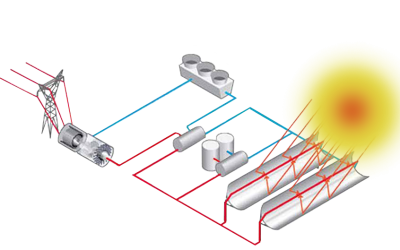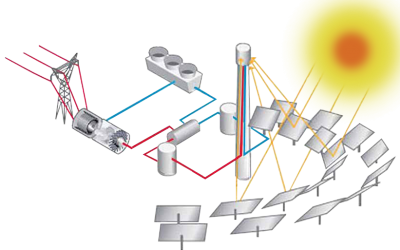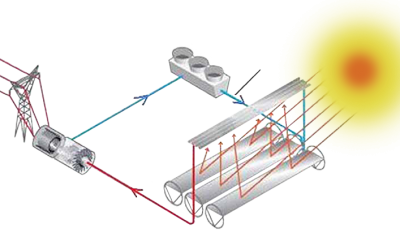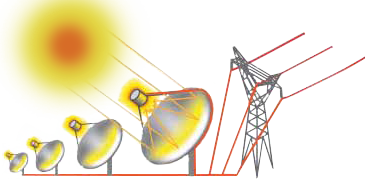Concentrating Solar Power plants produce electricity in a similar way to conventional power stations – using steam to drive a turbine. The difference is that their energy comes from solar radiation converted to high-temperature steam or gas. Four main elements are required: a concentrator, a receiver, some form of transport media or storage, and power conversion. Many different types of systems are possible, including combinations with other renewable and non-renewable technologies.
Parabolic Trough technology consists of installing rows or loops of parabolic trough-shaped mirror reflectors that are used to collect the solar radiation and concentrate it onto a thermally efficient receiver tube placed in the trough’s focal line. The fluid is heated up to approximately 400°C by the concentrated sun’s rays and then pumped through a series of heat exchangers to produce superheated steam. The steam is converted to electrical energy in a conventional steam turbine generator, which can either be part of a conventional steam cycle or integrated into a combined steam and gas turbine cycle. This fluid can also be used to heat a storage system consisting of two tanks of molten salt.

A circular array of heliostats (large mirrors with sun-tracking motion) concentrates sunlight on to a central receiver mounted at the top of a tower. A heat-transfer medium in this central receiver absorbs the highly concentrated radiation reflected by the heliostats and converts it into thermal energy that is used to generate of superheated steam for the turbine. To date, the heat transfer media demonstrated include water/steam, molten salts, liquid sodium and air. If pressurised gas or air is used at very high temperatures of about 1,000°C or more as the heat transfer medium, it can even be used to directly replace natural gas in a gas turbine, making use of the excellent cycle (60% and more) of modern gas and steam combined cycles.

An array of nearly flat reflectors concentrate solar radiation onto elevated inverted linear receivers. Water flows through the receivers and is converted into steam. This system is linear-concentrating, similar to a parabolic trough, with the advantages of low costs for structural support and reflectors, fixed fluid joints, a receiver separated from the reflector system, and long focal lengths which allows the use of flat mirrors. The technology is seen as a potentially lower-cost alternative to trough technology for the production of solar process heat and steam.

A parabolic dish-shaped reflector concentrates sunlight on to a receiver located at the focal point of the dish. The concentrated beam radiation is absorbed into the receiver to heat a fluid or gas (air) to approximately 750°C. This fluid or gas is then used to generate electricity in a small piston or Stirling engine or a micro turbine, attached to the receiver. The troughs are usually designed to track the Sun along one axis, predominantly north–south.
